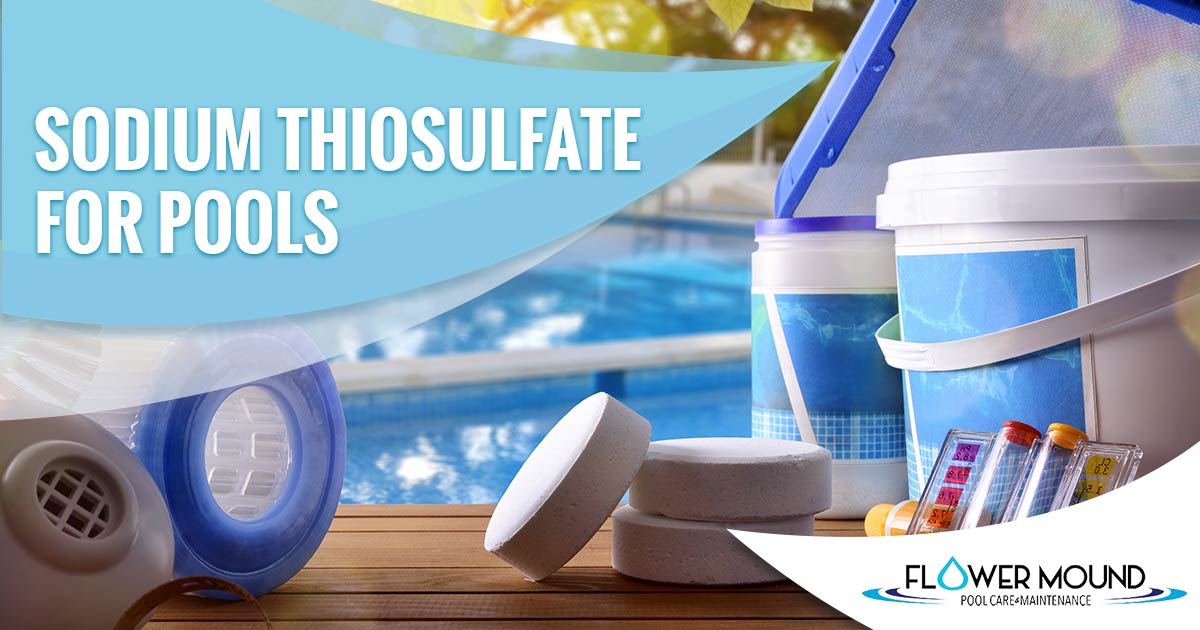Owning a pool means educating yourself about various parts of your pool as well as maintenance. A big part of that education comes in keeping your pool water clean and balanced. While we’re not all chemists, having knowledge of the chemicals that are going into your pool is important. This lets you know what to look for when the water isn’t looking so hot and what could help to fix it.
While many people are familiar with chlorine for their pool, you may not know much about sodium thiosulfate. Sodium thiosulfate is a chemical that’s important for having balanced water levels. Let’s take a look at sodium thiosulfate for pools and how it is used.
What is Sodium Thiosulfate for Pools?
By definition, sodium thiosulfate is an inorganic sodium salt made of sodium and thiosulfate ions. These are in a 2:1 ratio. Sodium thiosulfate has many roles including being used as an antidote to cyanide poisoning as well as an antifungal drug.
For our purposes in the pool, sodium thiosulfate is used to reduce the amount of chlorine. While we all know pools need chlorine, there are times when there can be too much chlorine in the pool. This can lead to itchy eyes, skin sensitivity, and even difficulty breathing. You want to bring those levels down so that everyone can be safe and have a fun time in your pool. Sodium thiosulfate is known as a chlorine neutralizer that can do that. In fact, it’s the go-to product many pool owners use when they have too much chlorine in their pool.
By testing your water, you can tell if your pool has too much chlorine. Some people say they can tell when there’s too much chlorine because they can smell the chlorine in the pool. But, this is not an accurate way of knowing the chemical levels in the pool. Testing for them will give you true results.
You can test your pool water yourself by using pool strips found in a pool store or you can let the experts at Flower Mound Pool Care & Maintenance do it for you. As part of our weekly pool service, we will test your water to see what chemicals are needed. When you turn to us for your pool needs, you can feel confident that your water is being treated properly. It takes the hassle off of your hands and the guesswork out of knowing what to add and how much.
How is Sodium Thiosulfate for Pools Used?
Sodium thiosulfate for pools removes free chlorine as well as combined chlorine (chloramines) from pools. It’s an easy, safe, and inexpensive way to balance the chemical levels in your pool. There are no negative side effects of using sodium thiosulfate for pools, so you don’t have to worry.
To use it, you add about one cup for every 5,000 gallons of water that’s in your pool. So, if you’re doing this yourself, you need to know how much water your pool holds. When you use sodium thiosulfate as directed, you will lower your chlorine levels by around 10ppm.
If you don’t, you risk using too little where it will be ineffective, or too much where your chlorine levels will be too low. This can be a problem when you try to sterilize your swimming pool. Any type of chlorine neutralizers take a few days to dissipate from pool water.
Are There Alternatives to Sodium Thiosulfate for Pools?
Sodium thiosulfate is the preferred way to lower chlorine in the pool because it is deemed to be the safest. There are other ways to lower the chlorine in pools, but they are not as effective as sodium thiosulfate.
You may have heard of people using hydrogen peroxide to lower the chlorine in their pool. While concentrated hydrogen peroxide is specially formulated to use as a shock oxidizer in the pool, it kills everything including chlorine. Hydrogen peroxide is not made to only reduce chlorine so it may be hard to find out how much you would need to treat your pool. This is one of the reasons why it’s not recommended.
Ascorbic acid is another option that can remove chlorine. It’s not usually sold as a chlorine neutralizer, but can be a great stain remover. It can still work lower chlorine levels in pools with a balanced pH. This method is more expensive than using sodium thiosulfate. It can also be hard to figure out how much you need to lower the amount of chlorine in your water. This is why this is also not always recommended.
As you can tell, using sodium thiosulfate for pools is the preferred option because it’s less expensive, more effective, and easier to use.
Contact Us for Your Pool Care
We know that taking care of your pool can be time-consuming and sometimes confusing. That’s why we’re here to help. Many people trust Flower Mound Pool Care & Maintenance because of our highly skilled and trained technicians.
With weekly pool service from our professional staff, you receive a 23-point plan that details every step we’re taking to clean and maintain your pool. This way there is no guesswork about what’s being done. Our customers enjoy our transparent approach to the way we do business. We also take photos and send e-mail updates so our customers always stay informed.
Our technicians also don’t try to sell unneeded services. This is something that our customers especially appreciate. Also, when you trust us with your weekly pool service, we provide one flat monthly fee regardless if there are four or five weeks in the month. This allows you to budget appropriately.
Besides cleaning your pool and helping you maintain safe chemical levels in your pool, Flower Mound Pool Care & Maintenance can also take care of other needs like pool resurfacing and pool remodeling.

